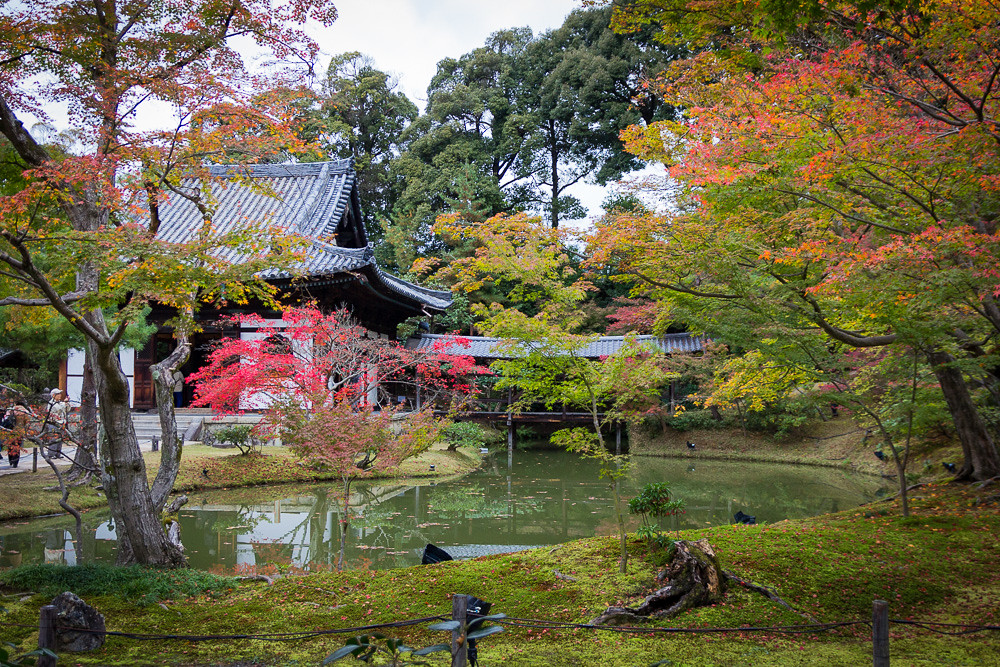Famous tea houses in Kyoto
Tai An
 Tai an at Myokian Temple, Hiroto Okada
Tai an at Myokian Temple, Hiroto Okada
Tai An was built in the Oyamazaki area of Kyoto near Uji, where the best tea leaves are grown. It is considered a national treasure. It was built during the Momoyama Period (1582). It is said that the teahouse was built to help Toyotomi Hideyoshi’s meeting with the other samurai after the death of Oda Nobunaga. It has a great interesting history. Tai An tea house in Kyoto is an architectural heritage of the nation. It is an incredible masterpiece of Japanese culture, that's why it is strongly recommended to visit.
Tai An is known as one of the smallest teahouses in Japan, where there is one tatami mat for the guest and one tatami mat for the host. The height from the floor to the ceiling is only 170 cm.
Tai An location and hours:
Ihoan tea hut
Ihoan tea hut is located near the edge of central Kyoto. It is located inside Kodaiji Temple. It was designed by Kobori Enshu, who was an architect and master Zen gardener. Ihoan tea hut is also known as the “Cottage of ingering Fragrance” and is a representative of Kodaiji temple’s tea ceremony architecture.
 Ihoan tea hut at Kodaiji Temple, Christian Kaden
Ihoan tea hut at Kodaiji Temple, Christian Kaden
Ihoan location and hours:
Shosei-en
 Shosei-en Garden, 中西禎之
Shosei-en Garden, 中西禎之
Shosei-en is a garden located in the center of Kyoto. This garden is the detached garden and property of Higashi Honganji Temple. It is believed to have been created in 1641, although some debate it is even older than that, but no matter what you believe the current gardener was built in the 19th century after it was burned down in two fires in 1858, and 1864
Shosei-en location and hours:
Ōkōchi Sansō
Ōkōchi Sansō is located in Arashiyama. It was once the residence of Ōkōchi Denjirō a famous film star of early Japanese cinema. It is a beautiful garden that has many unique features. Such as the Myōkō-an Hall, Ōkochi enjiro Museum, Jibutsu-dō hall, and more. I have one of the best views of Kyoto to look over the city.
 Okochi Sanso Garden, Song Tree
Okochi Sanso Garden, Song Tree
It was first built in the early 1900s to last as the actor's estate, over the actor's life it was slowly renovated until his death. After he died he passed the estate on to his wife who would gradually open it to the public. Interestingly the estate also offers tea and snacks to all those who visit. Ōkōchi Sansō is open every day, from 9 am to 5 pm. I take around 30min by train to get to Ōkōchi Sansō from Kyoto station.
Ōkōchi Sansō location and hours:
Ichiriki Chaya
 Ichiriki-tei, nanda koreha
Ichiriki-tei, nanda koreha
Ichiriki Chaya is located in the east of Kyoto in the Gion district. It has a 300-year-old history, and has been a center of the Gion district for centuries. It has been the center of political intrigue for many historic events. 47 samurai have been at the center of the plotting of the overthrow of the Tokugawa shogunate.
However, this tea house is not your normal teahouse. It is more of a place for general entertainment, it is where you can have first-class meals and hospitality, and beautiful Geisha entertainment. Although, it is not easily accessed. Many customers' families have been patrons of this location for generations. To get in, you will need an invitation, which is very hard to get, but once you got there, you will need to pay the price of this exclusivity. A night with Geisha or Maiko entertainment can cost between 500,000 yen to 800,000 yen and up. It takes around 20 minutes to arrive at Ichiriki Chaya from Kyoto station by subway.
Ichiriki Chaya location
Shokin-tei
 Shokin-tei, 山脇孝之
Shokin-tei, 山脇孝之
Shokin-tei is located in the west of Kyoto. This tea house is located in the Katsura Rikyu Imperial Villa, which is one of Japan's most important national treasures. Shokin-tei is the most important out of the four tea houses at this imperial villa. This tea house is also known because it has a very unique blue and white checker pattern on the sliding door and tokonoma of the first room.
This building has unique architecture, with the north, east, south, and west views, each having its own look. Also, the entrance of the tea house is very small, meaning that you would not be able to carry a sword into the tea house, guaranteeing a peaceful meeting. Although in order to visit Katsura Rikyu Imperial Villa where the tea house is located, you must first apply to visit the Kunaicho (Imperial Household Office).
Hours for tours can be irregular, but it often has tours on weekdays from 10 am to 3 pm and is closed on weekends and holidays, just make sure to apply to visit before going. It takes around 30min to get to Katsura Rikyu Imperial Villa where the tea house is located from Kyoto Station.
Shokin-tei location








